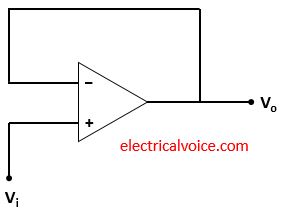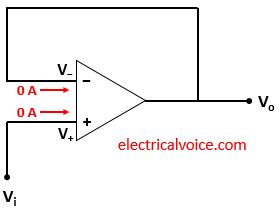Voltage follower is an op-amp circuit that has a voltage gain of unity. It means that whatever voltage is applied at the input of the op-amp, the same voltage comes at the op-amp output. There is no amplification of the voltage. Hence we can say that the output voltage directly follows the input voltage. The other common names for the voltage follower are isolation amplifier, buffer amplifier and unity-gain amplifier. This circuit acts as a buffer because it provides no attenuation or amplification to the input signal. In this article, we will see the voltage follower circuit, its working, its advantages and its applications.
Voltage Follower Circuit

Voltage follower circuit is shown in figure 1. The input current Vi is applied to the non-inverting terminal. Vo is the output voltage. The inverting terminal of the op-amp is directly connected to the op-amp output.
Analysis
The analysis of the voltage follower circuit is shown in figure 2. Since the op-amp is ideal, the voltage of the inverting terminal (V−) is equal to the voltage of the non-inverting terminal (V+ = Vi), according to the virtual short concept.
V− = V+ = Vi
The currents entering both terminals of the op-amp are zero since the op-amp is ideal.

As from figure 2, V− = Vo = Vi
Therefore
V− = Vo = Vi
\[
\quicklatex{color=”#000000″ size=20}
\boxed{V_o=V_i}
\]
Voltage follower Advantages
1. The op-amp takes zero current from the input as shown in figure 2.
2. The loading effects can be avoided.
3. It provides low output impedance with those circuits which use the output of the voltage follower.
Voltage follower Applications
1. used in bridge circuits using transducers
2. used in active filters
3. used in sample and hold circuits.
4. as a buffer for logic circuits.
